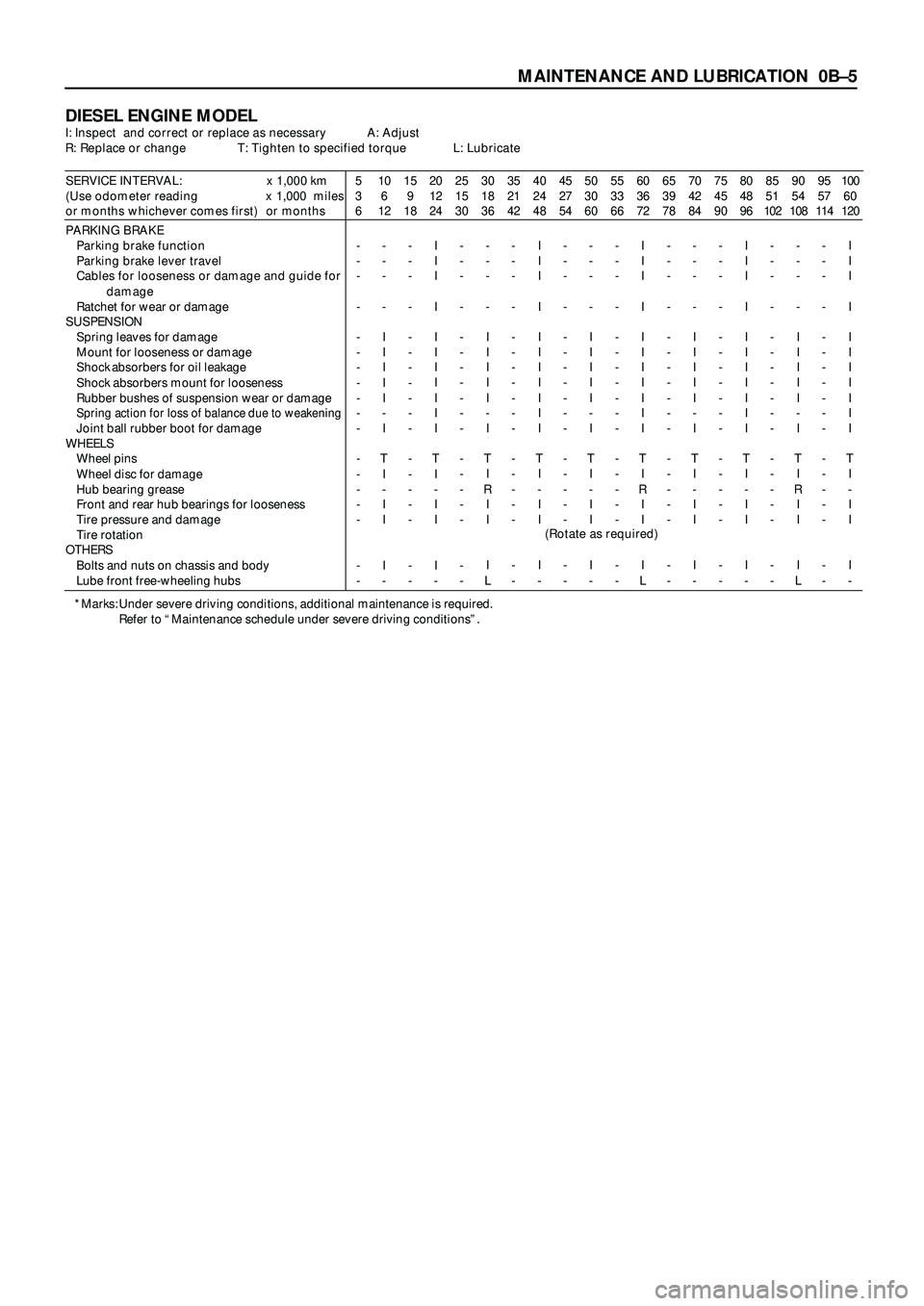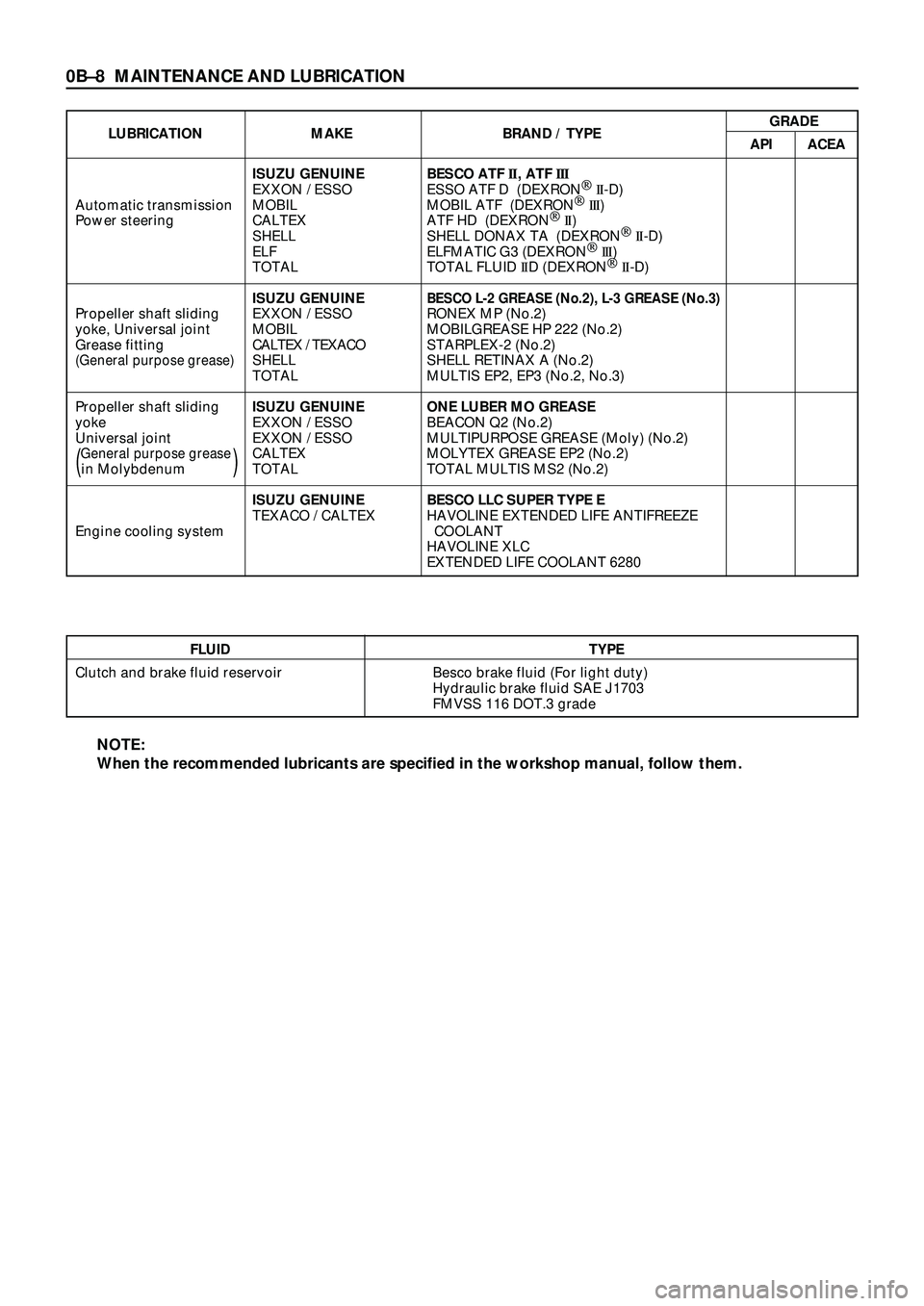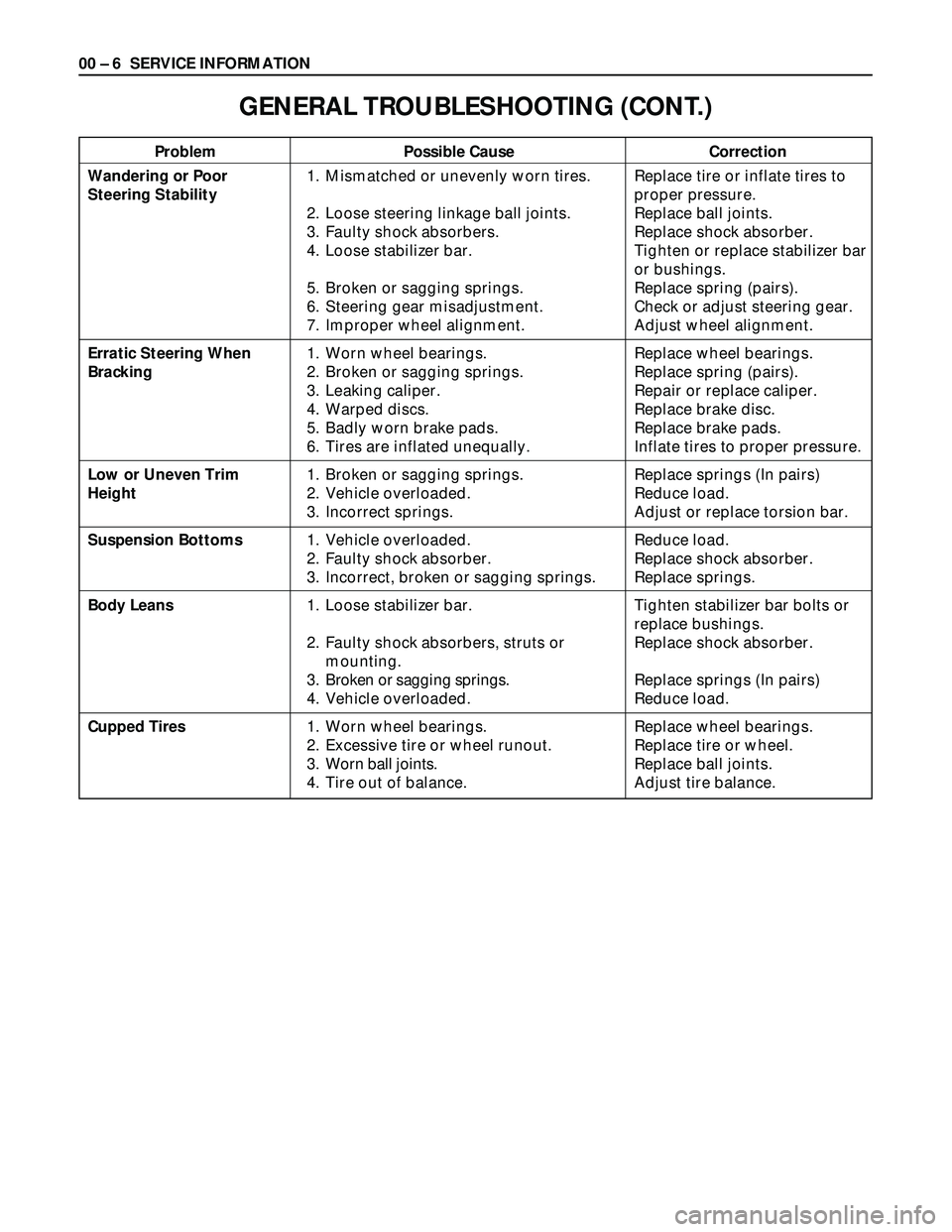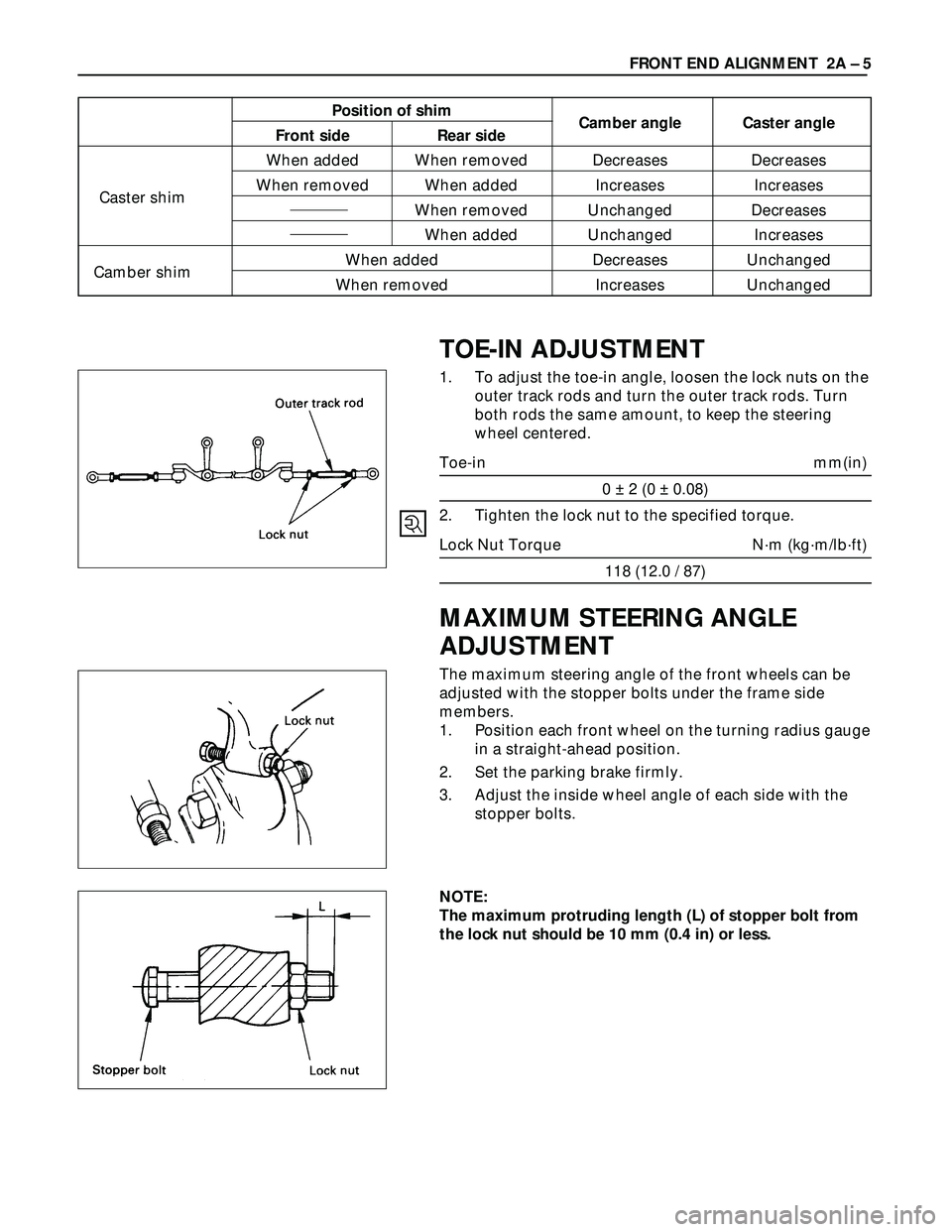1998 ISUZU TROOPER brake
[x] Cancel search: brakePage 32 of 3573

MAINTENANCE AND LUBRICATION 0BÐ5
DIESEL ENGINE MODELI: Inspect and correct or replace as necessary A: Adjust
R: Replace or change T: Tighten to specified torque L: Lubricate
SERVICE INTERVAL: x 1,000 km
(Use odometer reading x 1,000 miles
or months whichever comes first) or months5
3
610
6
1215
9
1820
12
2425
15
3030
18
3635
21
4240
24
4845
27
5450
30
6055
33
6660
36
7265
39
7870
42
8475
45
9080
48
9685
51
10290
54
10895
57
114100
60
120
PARKING BRAKE
Parking brake function
Parking brake lever travel
Cables for looseness or damage and guide for
damage
Ratchet for wear or damage
SUSPENSION
Spring leaves for damage
Mount for looseness or damage
Shock absorbers for oil leakage
Shock absorbers mount for looseness
Rubber bushes of suspension wear or damage
Spring action for loss of balance due to weakeningJoint ball rubber boot for damage
WHEELS
Wheel pins
Wheel disc for damage
Hub bearing grease
Front and rear hub bearings for looseness
Tire pressure and damage
Tire rotation
OTHERS
Bolts and nuts on chassis and body
Lube front free-wheeling hubs-
-
-
-
-
-
-
-
-
-
-
-
-
-
-
-
-
--
-
-
-
I
I
I
I
I
-
I
T
I
-
I
I
I
--
-
-
-
-
-
-
-
-
-
-
-
-
-
-
-
-
-I
I
I
I
I
I
I
I
I
I
I
T
I
-
I
I
I
--
-
-
-
-
-
-
-
-
-
-
-
-
-
-
-
-
--
-
-
-
I
I
I
I
I
-
I
T
I
R
I
I
I
L-
-
-
-
-
-
-
-
-
-
-
-
-
-
-
-
-
-I
I
I
I
I
I
I
I
I
I
I
T
I
-
I
I
I
--
-
-
-
-
-
-
-
-
-
-
-
-
-
-
-
-
--
-
-
-
I
I
I
I
I
-
I
T
I
-
I
I
I
--
-
-
-
-
-
-
-
-
-
-
-
-
-
-
-
-
-I
I
I
I
I
I
I
I
I
I
I
T
I
R
I
I
I
L-
-
-
-
-
-
-
-
-
-
-
-
-
-
-
-
-
--
-
-
-
I
I
I
I
I
-
I
T
I
-
I
I
I
--
-
-
-
-
-
-
-
-
-
-
-
-
-
-
-
-
-I
I
I
I
I
I
I
I
I
I
I
T
I
-
I
I
I
--
-
-
-
-
-
-
-
-
-
-
-
-
-
-
-
-
--
-
-
-
I
I
I
I
I
-
I
T
I
R
I
I
I
L-
-
-
-
-
-
-
-
-
-
-
-
-
-
-
-
-
-I
I
I
I
I
I
I
I
I
I
I
T
I
-
I
I
I
-
(Rotate as required)
*Marks: Under severe driving conditions, additional maintenance is required.
Refer to “Maintenance schedule under severe driving conditions”.
Page 33 of 3573

0BÐ6 MAINTENANCE AND LUBRICATION
Item IntervalCondition
ABCD A+D
Engine oil G : Change every 5,000 km (3,000 miles)
D : Change every 5,000 km (3,000 miles) ll
Engine oil filter G : Replace every 10,000 km (6,000 miles)
D : Replace every 5,000 km (3,000 miles) ll
Air cleaner element G : Replace every 20,000 km (12,000 miles)
D : Replace every 40,000 km (25,000 miles)l
Power steering fluid Replace every 50,000 km (30,000 miles)ll
Steering system for looseness
or damage Inspect every 5,000 km (3,000 miles)l
Universal joints and sleeves Inspect for wear and lubricate every 7,500 km (4,500 miles)ll
Transmission with MT Change every 20,000 km (12,000 miles)
transfer case oil after changing at initial 10,000 km (6,000 miles)l
Transmission :
AT
Change every 32,000 km (20,000 miles) lll l
Transfer:
TF Change every 20,000 km (12,000 miles)
after changing at initial 10,000 km (6,000 miles)l
Differential oil Change every 20,000 km (12,000 miles)
after changing at initial 5,000 km (3,000 miles) l
Disc brake pads and discs Inspect every 5,000 km (3,000 miles)lll
Timing belt G : Replace every 120,000 km (75,000 miles)ll
EXPLANATION OF COMPLETE VEHICLE MAINTENANCE SCHEDULE
Explanations of the services listed in the proceeding
Maintenance Scheduled are presented in ÒService
InformationÓ section of each manual.Replace all questionable parts and note any
necessary repairs as you perform these
maintenance procedures.
MAINTENANCE SCHEDULE UNDER SEVERE DRIVING CONDITIONS
Severe driving conditions
A: Repeated short trips
B: Driving on rough roads
C: Driving on dusty roads
D: Driving in extremely cold weather and/or salted roads
Page 35 of 3573

0BÐ8 MAINTENANCE AND LUBRICATION
FLUID TYPE
Clutch and brake fluid reservoir Besco brake fluid (For light duty)
Hydraulic brake fluid SAE J1703
FMVSS 116 DOT.3 grade
LUBRICATION MAKE BRAND / TYPEGRADE
API ACEA
ISUZU GENUINE BESCO ATF II, ATF III
EXXON / ESSO ESSO ATF D (DEXRONÒ
II-D)
Automatic transmission MOBIL MOBIL ATF (DEXRONÒ
III)
Power steering CALTEX ATF HD (DEXRONÒ
II)
SHELL SHELL DONAX TA (DEXRONÒ
II-D)
ELF ELFMATIC G3 (DEXRONÒ
III)
TOTAL TOTAL FLUID IID (DEXRONÒ
II-D)
ISUZU GENUINE
BESCO L-2 GREASE (No.2), L-3 GREASE (No.3)Propeller shaft sliding EXXON / ESSO RONEX MP (No.2)
yoke, Universal joint MOBIL MOBILGREASE HP 222 (No.2)
Grease fittingCALTEX / TEXACOSTARPLEX-2 (No.2)
(General purpose grease)SHELL SHELL RETINAX A (No.2)
TOTAL MULTIS EP2, EP3 (No.2, No.3)
Propeller shaft slidingISUZU GENUINE ONE LUBER MO GREASE
yoke EXXON / ESSO BEACON Q2 (No.2)
Universal joint EXXON / ESSO MULTIPURPOSE GREASE (Moly) (No.2)
General purpose greaseCALTEX MOLYTEX GREASE EP2 (No.2)(in Molybdenum)TOTAL TOTAL MULTIS MS2 (No.2)
ISUZU GENUINE BESCO LLC SUPER TYPE E
TEXACO / CALTEX HAVOLINE EXTENDED LIFE ANTIFREEZE
Engine cooling system COOLANT
HAVOLINE XLC
EXTENDED LIFE COOLANT 6280
NOTE:
When the recommended lubricants are specified in the workshop manual, follow them.
Page 286 of 3573

Problem Possible Cause Correction
00 – 4 SERVICE INFORMATION
GENERAL INFORMATION
Since the problems in steering, suspension,
wheels and tires involve several systems, they
must all be considered when diagnosing a
complaint. To identify the symptom, always road
test the vehicle first.
Proceed with the following preliminary inspections
and correct any defects which are found.1. Inspect tires for proper pressure and uneven
wear.
2. Raise vehicle on a hoist and inspect front and
rear suspension and steering linkage for loose
or damaged parts.
3. Spin front wheels. Inspect for out-of-round
tires, out-of-balance tires, loose and/or rough
wheel bearings.
GENERAL TROUBLESHOOTING
Vehicle Pulls
Abnormal or Excessive
Tire Wear
Shimmy, Shake or
Vibration1. Mismatched or uneven tires.
2. Tires not adequately inflated.
3. Broken or sagging springs.
4. Radial tire lateral force.
5. Improper wheel alignment.
6. Brake dragging in one wheel.
7. Loose, bent or broken front or rear
suspension parts.
8. Faulty shock absorbers.
1. Sagging or broken spring.
2. Tire out of balance.
3. Improper wheel alignment.
4. Faulty shock absorber.
5. Hard driving.
6. Overloaded vehicle.
7. Tires not rotated periodically.
8. Worn or loose road wheel bearings.
9. Wobbly wheel or tires.
10. Tires not adequately inflated.
1. Tire or wheel out of balance.
2. Loose wheel bearings.
3. Worn steering linkage ball joints.
4. Worn upper or lower end ball joints.
5. Excessively upper wheel runout.
6. Blister or bump on tire.
7. Excessive loaded radial run out of
tire/wheel assembly.
8. Improper wheel alignment.
9. Loose or worn steering linkage.
10. Loose steering gear.
11. Tires not adequately inflated.
12. Loose, bent or broken front or rear
suspension parts.
13. Faulty shock absorber.
14. Hub bearing preload misadjustment.Replace tire.
Adjust tire pressure.
Replace spring.
Replace tire.
Adjust wheel alignment.
Repair brake.
Tighten or replace the
appropriate suspension part(s).
Replace shock absorber.
Replace spring.
Balance or replace tire.
Check front end alignment.
Replace shock absorber.
Replace tire.
Replace tire and reduce load.
Replace or rotate tire.
Replace wheel bearing.
Replace wheel or tire.
Adjust the pressure.
Balance wheels or replace
tire/or wheel.
Replace wheel bearing.
Replace ball joints.
Replace ball joints.
Repair or replace wheel
and/or tire.
Replace tire.
Replace tire or wheel.
Check wheel alignment.
Tighten or replace steering
linkage.
Tighten housing bolts.
Adjust tire pressure.
Tighten or replace the
appropriate suspension parts.
Replace shock absorber.
Adjust preload.
Page 288 of 3573

00 – 6 SERVICE INFORMATION
Problem Possible Cause Correction
GENERAL TROUBLESHOOTING (CONT.)
Wandering or Poor
Steering Stability
Erratic Steering When
Bracking
Low or Uneven Trim
Height
Suspension Bottoms
Body Leans
Cupped Tires1. Mismatched or unevenly worn tires.
2. Loose steering linkage ball joints.
3. Faulty shock absorbers.
4. Loose stabilizer bar.
5. Broken or sagging springs.
6. Steering gear misadjustment.
7. Improper wheel alignment.
1. Worn wheel bearings.
2. Broken or sagging springs.
3. Leaking caliper.
4. Warped discs.
5. Badly worn brake pads.
6. Tires are inflated unequally.
1. Broken or sagging springs.
2. Vehicle overloaded.
3. Incorrect springs.
1. Vehicle overloaded.
2. Faulty shock absorber.
3. Incorrect, broken or sagging springs.
1. Loose stabilizer bar.
2. Faulty shock absorbers, struts or
mounting.
3. Broken or sagging springs.
4. Vehicle overloaded.
1. Worn wheel bearings.
2. Excessive tire or wheel runout.
3. Worn ball joints.
4. Tire out of balance.Replace tire or inflate tires to
proper pressure.
Replace ball joints.
Replace shock absorber.
Tighten or replace stabilizer bar
or bushings.
Replace spring (pairs).
Check or adjust steering gear.
Adjust wheel alignment.
Replace wheel bearings.
Replace spring (pairs).
Repair or replace caliper.
Replace brake disc.
Replace brake pads.
Inflate tires to proper pressure.
Replace springs (In pairs)
Reduce load.
Adjust or replace torsion bar.
Reduce load.
Replace shock absorber.
Replace springs.
Tighten stabilizer bar bolts or
replace bushings.
Replace shock absorber.
Replace springs (In pairs)
Reduce load.
Replace wheel bearings.
Replace tire or wheel.
Replace ball joints.
Adjust tire balance.
Page 289 of 3573

SERVICE INFORMATION 00 – 7
Problem Possible Cause Correction
POWER STEERING SYSTEM
HISSING NOISE
There is some noise in all power steering systems. One of the most common is a hissing sound when the
steering wheel is fully turned and the car is not moving. This noise will be most evident when the wheel is
operated while the brakes are applied. There is no relationship between this noise and steering
performance. Do not replace the valve unless the "hissing" noise is extremely objectionable. A replacement
valve will also have a slight noise, and is not always a cure for the condition.
Rattle or Chucking Noise
Poor Return of Steering
Wheel to Center
Momentary Increase in
Effort When Turning
Wheel Fast to Right or
Left
Steering Wheel Surges or
Jerks When Turning
Especially During Parking
Excessive Wheel Kick
Back or Loose Steering
Hard Steering or Lack of
Power Assist1. Pressure hose touching other parts of
vehicle.
2. Tie rod ends loose.
3. Loose steering gear mounting.
4. Steering gear misadjustment.
1. Improper front wheel alignment.
2. Wheel bearing worn.
3. Tie rod end binding.
4. Ball joint binding.
5. Tight or frozen steering shaft bearing.
6. Steering gear misadjustment.
7. Sticky or plugged steering gear valve.
8. Entry of air in the power steering
system.
1. High internal leakage.
2. Power steering fluid level low.
1. Insufficient pump pressure.
2. Sticky steering gear valve.
3. Power steering fluid level low.
1. Air in system.
2. Tie rod end loose.
3. Wheel bearing worn.
1. Sticky steering gear valve.
2. Insufficient pump pressure.
3. Excessive internal pump leakage.
4. Excessive internal steering gear
leakage.
5. Power steering fluid level low.Adjust hose position. Do not
bend tubing by hand.
Tighten or replace tie rod end.
Tighten steering gear
mounting.
Check and adjust steering gear
preload.
Adjust front wheel alignment.
Replace front wheel bearing.
Replace tie rod end.
Replace ball joint.
Replace steering assembly.
Adjust the steering gear.
Repair or replace steering gear
valve.
Bleed the system.
Repair steering gear.
Replenish fluid.
Repair pump assembly.
Repair or replace steering gear.
Replenish fluid.
Bleed hydraulic system.
Tighten tie rod end.
Replace wheel bearing.
Repair or replace steering gear
valve.
Repair pump assembly.
Repair pump assembly.
Repair steering gear.
Replenish fluid.
Page 307 of 3573

FRONT END ALIGNMENT 2A – 5
Position of shim
Camber angle Caster angle
Front side Rear side
When added When removed Decreases Decreases
When removed When added Increases Increases
Caster shim
When removed Unchanged Decreases
When added Unchanged Increases
When added Decreases Unchanged
Camber shim
When removed Increases Unchanged
TOE-IN ADJUSTMENT
1. To adjust the toe-in angle, loosen the lock nuts on the
outer track rods and turn the outer track rods. Turn
both rods the same amount, to keep the steering
wheel centered.
Toe-in mm(in)
0 ± 2 (0 ± 0.08)
2. Tighten the lock nut to the specified torque.
Lock Nut Torque N·m (kg·m/lb·ft)
118 (12.0 / 87)
MAXIMUM STEERING ANGLE
ADJUSTMENT
The maximum steering angle of the front wheels can be
adjusted with the stopper bolts under the frame side
members.
1. Position each front wheel on the turning radius gauge
in a straight-ahead position.
2. Set the parking brake firmly.
3. Adjust the inside wheel angle of each side with the
stopper bolts.
NOTE:
The maximum protruding length (L) of stopper bolt from
the lock nut should be 10 mm (0.4 in) or less.
Page 399 of 3573

FRONT SUSPENSION 3C – 11
REMOVAL
Preparation:
1) Raise the vehicle and support the frame with suitable
safety stands.
2) Remove wheel and tire assembly. Refer to “Wheels
and Tires” in section 3E.
3) Remove the brake caliper. Refer to “Brakes” in section
5.
4) Remove the hub assembly. Refer to “Hub and Disk” in
section 4C.
5) Remove outer track rod from the knuckle. Refer to
“Steering Linkage” in section 2A.
1. Torsion Bar
Loosen torsion bar by height control arm adjust bolt.
Refer to “Torsion bar” in this section.
2. Wheel speed sensor (if equipped with ABS)
3. Back Plate
4. Lower Ball Joint
Remover: 5-8840-2005-0 (J-29107)
CAUTION:
Be careful not to break the ball joint boot.
5. Upper Ball Joint
Remover: 5-8840-2121-0 (J-36831)
CAUTION:
Be careful not to break the ball joint boot.
6. Knuckle Assembly
7. Oil Seal
8. Washer
9. Needle Bearing
Remover: 5-8840-0019-0 (J-23907)